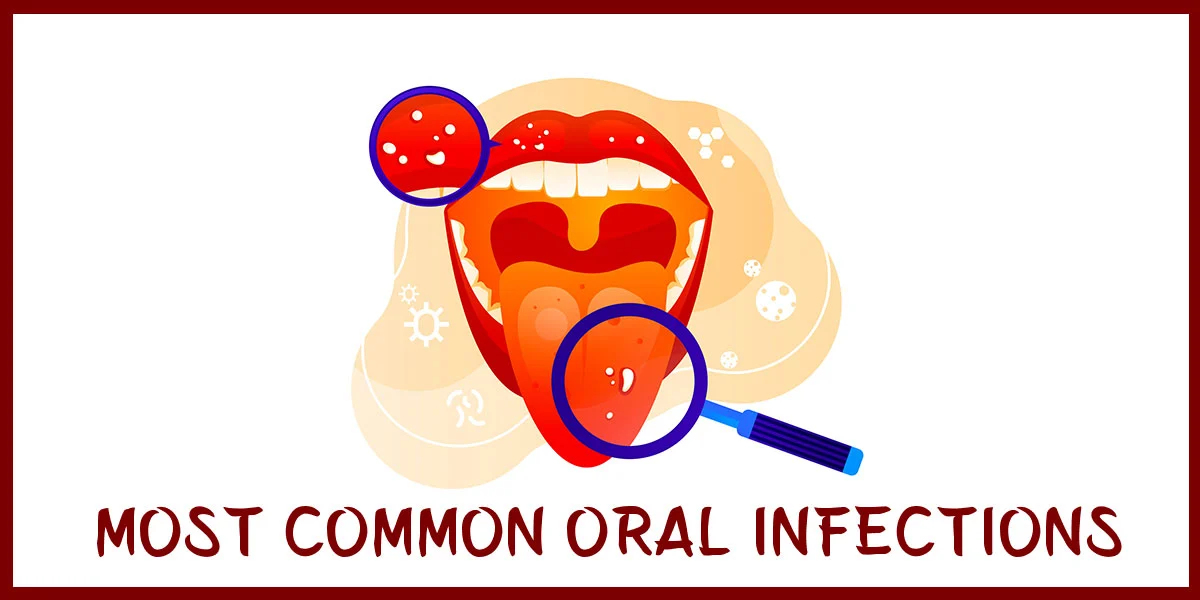Oral infections refer to infections that occur in the mouth and its associated structures. They can range from mild, localized infections to more severe conditions that affect the entire oral cavity.
The mouth is a complex environment that houses various bacteria, viruses, and fungi, both harmful and beneficial. When the balance of microorganisms is disrupted or when pathogens (disease-causing agents) gain the upper hand, oral infections can occur.
Some common oral infections include:
- Tooth Decay (Dental Caries): This is one of the most prevalent oral infections. Bacteria in the mouth produce acids that erode the tooth enamel, leading to cavities or holes in the teeth.Tooth decay, also known as dental caries or cavities, is a common dental problem that occurs when the structure of the tooth is damaged due to acid produced by bacteria present in plaque, a sticky film that forms on teeth. Tooth decay can lead to the formation of small holes or openings in the hard surface of the tooth, known as cavities.
Here’s how tooth decay typically develops:
1. Plaque Formation: Plaque is a sticky, colorless film that forms on teeth and contains bacteria. These bacteria feed on the sugars and carbohydrates present in the food we eat, producing acids as byproducts.
2. Acid Attack: The acids produced by the bacteria in plaque gradually erode the enamel, which is the hard outer layer of the tooth. This process is called demoralization.
3. Cavity Formation: As the enamel continues to weaken, the acids eventually reach the dentin, which is the softer, inner layer of the tooth. The dentin is more vulnerable to acid attacks, and the decay process accelerates. Once the dentin is affected, the decay can progress more rapidly, leading to the formation of a cavity.
4. Spreading Decay: If the cavity is left untreated, the decay can progress deeper into the tooth, potentially reaching the pulp chamber, which contains nerves and blood vessels. At this stage, the tooth becomes extremely sensitive and painful.
Factors contributing to tooth decay include:–
– Poor oral hygiene: Inadequate brushing and flossing can lead to the accumulation of plaque and bacteria.
– Sugary and acidic diet: Frequent consumption of sugary and acidic foods and drinks provides more fuel for the bacteria to produce damaging acids.
– Dry mouth: Saliva plays a crucial role in neutralizing acids and protecting teeth. A dry mouth can increase the risk of tooth decay.
– Lack of fluoride: Fluoride helps strengthen tooth enamel and make it more resistant to acid attacks. Insufficient fluoride intake can make teeth more susceptible to decay.
– Poor dental care: Irregular dental check-ups and cleanings may allow decay to progress unnoticed and untreated.Preventing tooth decay involves maintaining good oral hygiene practices, including brushing teeth twice a day with fluoride toothpaste, flossing daily, and visiting the dentist regularly for check-ups and cleanings. Additionally, reducing the consumption of sugary and acidic foods and drinks can help minimize the risk of tooth decay.If tooth decay is detected early, it can be treated with dental fillings to restore the damaged tooth structure. However, if the decay has progressed significantly, more extensive treatments such as root canal therapy or dental crowns may be necessary to save the tooth. In severe cases where the tooth cannot be saved, extraction may be the only option. - Gingivitis: Gingivitis is a mild form of gum disease caused by the buildup of plaque on the teeth. It results in red, swollen, and tender gums that may bleed during brushing or flossing.Gingivitis is a common and mild form of gum disease (periodontal disease) that causes irritation, redness, and swelling (inflammation) of your gingiva, the part of your gum around the base of your teeth. It is often a result of poor oral hygiene habits that allow plaque, a sticky film of bacteria, to build up on the teeth and harden.
When plaque builds up on teeth, it can irritate the gingiva, leading to the signs and symptoms of gingivitis, which may include:
1. Red or swollen gums
2. Tender or bleeding gums, especially during brushing or flossing
3. Bad breath (halitosis)
4. Receding gum line
5. Soft, puffy gumsGingivitis is generally a mild and reversible condition, and with proper oral hygiene and regular dental check-ups, it can be prevented and treated. If left untreated, however, gingivitis can progress to a more serious form of gum disease called periodontitis. Periodontitis can cause the loss of bone and soft tissue that support the teeth, leading to tooth mobility and eventually tooth loss.The main cause of gingivitis is the accumulation of plaque on the teeth. Plaque is a sticky film of bacteria that continuously forms on teeth, and if not removed regularly through brushing and flossing, it can release harmful substances that irritate the gingiva and cause inflammation.
Factors that increase the risk of developing gingivitis include:
1. Poor oral hygiene: Not brushing and flossing regularly allows plaque to build up.
2. Smoking or chewing tobacco: These habits can increase the risk of gum problems.
3. Certain medications: Some medications can reduce saliva flow, leading to dry mouth, which can increase plaque buildup.
4. Certain medical conditions: Diseases like diabetes can make people more prone to infections, including gum disease.
5. Hormonal changes: Hormonal fluctuations during pregnancy, menstruation, or menopause can make gums more sensitive and prone to gingivitis.Treatment of gingivitis usually involves professional dental cleanings (scaling and root planing) to remove plaque and tartar (hardened plaque) from above and below the gum line. The dentist may also provide instructions on proper oral hygiene techniques and recommend using antiseptic mouthwash. In most cases, with good oral care at home and regular dental visits, gingivitis can be reversed, and gum health can be restored.
Preventing gingivitis involves maintaining good oral hygiene practices, including brushing teeth at least twice a day with fluoride toothpaste, flossing daily, and visiting the dentist for regular check-ups and cleanings. If you notice any signs of gingivitis, it’s essential to seek dental care promptly to prevent the condition from worsening. - Periodontitis: If gingivitis is left untreated, it can progress to periodontitis. This is a more severe form of gum disease where the infection spreads below the gumline and can lead to the deterioration of the gums, jawbone, and tooth loss.Periodontitis is a severe gum infection that damages the soft tissue and bone that support the teeth. It is a form of periodontal disease and is more advanced than gingivitis, which is the early stage of gum inflammation. Periodontitis is a common condition and one of the leading causes of tooth loss in adults.Causes: Periodontitis is primarily caused by bacteria present in dental plaque, a sticky film that forms on teeth and gums. When plaque is not adequately removed through regular brushing and flossing, it hardens into tartar (calculus), which cannot be removed with standard oral hygiene practices. The bacteria in plaque and tartar trigger an inflammatory response in the gums, leading to the progression of periodontal disease.Risk factors: Several factors can increase the risk of developing periodontitis, including:
- Poor oral hygiene: Inadequate brushing and flossing habits can allow plaque to accumulate, leading to gum disease.
- Smoking and tobacco use: Smoking reduces the body’s ability to fight off infections, including gum infections.
- Genetics: Some individuals may be genetically predisposed to developing gum disease.
- Diabetes: Uncontrolled diabetes can increase the risk of periodontitis.
- Certain medications: Some medications can reduce saliva flow, which can lead to dry mouth and an increased risk of gum disease.
- Hormonal changes: Hormonal fluctuations during pregnancy, menstruation, and menopause can make gums more sensitive and prone to gum disease.
- Poor nutrition: A diet lacking essential nutrients can weaken the immune system and make it harder for the body to fight off infections.
Symptoms: The symptoms of periodontitis may include:
- Red, swollen, or tender gums.
- Bleeding gums, especially during brushing or flossing.
- Receding gums, making teeth appear longer.
- Formation of pockets between the gums and teeth.
- Persistent bad breath.
- Loose or shifting teeth.
- Changes in the way teeth fit together when biting.
Treatment: Treatment for periodontitis aims to control the infection, halt the progression of the disease, and restore gum health. The following treatments may be recommended:
- Professional dental cleaning: A deep cleaning procedure called scaling and root planing is performed to remove plaque and tartar from below the gumline.
- Medications: Antibiotics or antimicrobial mouth rinses may be prescribed to control bacterial infection.
- Surgery: In advanced cases, surgical procedures such as flap surgery, bone grafts, or tissue grafts may be necessary to restore damaged tissues and bone.
Prevention: Preventing periodontitis involves maintaining good oral hygiene practices, including regular brushing, flossing, and dental check-ups. Avoiding smoking or tobacco use and maintaining a balanced diet also contribute to overall gum health.
If you suspect you have periodontitis or experience any of the symptoms mentioned, it’s essential to visit a dentist for a thorough evaluation and appropriate treatment. Early intervention can help prevent the progression of the disease and preserve your oral health.
- Periapical Abscess: This is a pocket of pus that forms at the tip of a tooth’s root due to an untreated dental infection. It can cause severe pain and swelling in the affected area.A periapical abscess is a localized collection of pus that forms at the tip (apex) of a tooth’s root. It occurs as a result of a bacterial infection that originates within the tooth’s pulp chamber. The pulp chamber is the innermost part of the tooth containing blood vessels, nerves, and connective tissue.Causes: Periapical abscesses typically occur due to untreated dental decay or a dental injury that allows bacteria to enter the pulp chamber. The bacteria multiply, leading to infection and inflammation within the tooth. As the infection progresses, pus accumulates at the root tip, causing pressure and pain.Symptoms: The symptoms of a periapical abscess may include:
- Severe toothache that may radiate to the jaw, ear, or neck.
- Swelling and tenderness in the gum near the affected tooth.
- Redness and warmth around the affected area.
- Sensitivity to hot or cold temperatures.
- Painful chewing or biting.
- Fever in more severe cases.
In some instances, the abscess may rupture, leading to the drainage of pus, which may temporarily relieve the pain. However, this is not a resolution, as the infection will persist and can spread to surrounding tissues.
Treatment: Prompt treatment is essential to address a periapical abscess and prevent further complications. Treatment options may include:
- Root Canal Therapy: This procedure involves removing the infected pulp from the tooth, cleaning the root canals, and sealing them. It helps eliminate the infection and save the tooth from extraction.
- Drainage: In some cases, a dentist may need to make a small incision in the gum to drain the pus from the abscess, providing immediate relief.
- Antibiotics: If the infection is severe or has spread to other areas, the dentist may prescribe antibiotics to control the infection.
- Pain Management: Over-the-counter pain relievers or prescription medication may be recommended to manage pain and inflammation.
- Dental Extraction: In cases where the tooth is severely damaged and cannot be saved, extraction may be necessary to prevent the spread of infection.
Prevention: Preventing periapical abscesses involves maintaining good oral hygiene practices, regular dental check-ups, and addressing dental issues promptly. This includes treating dental cavities, managing tooth fractures, and seeking dental care for any signs of tooth infection or inflammation.
If you experience symptoms of a periapical abscess, it is crucial to seek dental attention as soon as possible. Early intervention can prevent the infection from worsening and protect the affected tooth and surrounding tissues.
Read this Article also – Vaginal Infections (Vaginitis, Vaginosis) Symptoms and Treatment
If you don’t like this article/post please share your feedback.





